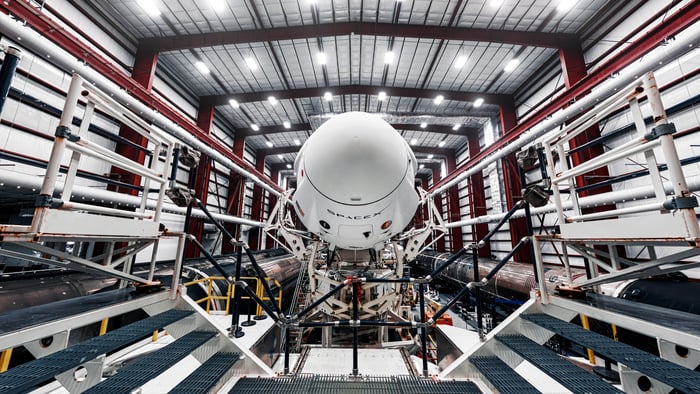Eight years ago, the business of space changed.
In 2014, NASA tapped SpaceX and Boeing (BA -1.18%) to build two new human-rated spacecraft, the Crew Dragon and Starliner, respectively. Each company would first prove its ship capable of safe flight, then perform as many as six crewed missions to the International Space Station.
Boeing hasn't yet been able to complete its test flights and hasn't performed even one crewed mission. But SpaceX? That contract has proved a resounding success.
SpaceX has completed four crewed spaceflights for NASA: the 2020 Demo-2 mission that marked America's return to crewed spaceflight, followed by Crew-1 later that year, and Crew-2 and Crew-3 in 2021. With Crew-4 slated to blast off on April 15, but Boeing still grounded, NASA has asked SpaceX to help keep the ISS stuffed full of astronauts in future years.

Image source: Getty Images.
Hello, Houston? We need more spaceships
Late last month, NASA announced it is modifying SpaceX's original 2014 Commercial Crew Transportation Capability (CCtCap) contract and awarding the company three new crewed spaceflight contracts.
Unsurprisingly (and unoriginally), NASA will call these three additional flights Crew-7, Crew-8, and Crew-9. To pay for them, NASA is adding $900 million to the $2.6 billion value of SpaceX's original CCtCap award, raising the value to $3.5 billion. That works out to roughly $300 million per mission and, divided by four astronauts per flight, a per-seat cost of $75 million.
But is that a lot or a little?
Ticket prices and inflation add up
The last time NASA bought rocket tickets for its astronauts from Roscosmos in 2018, the Russian space agency charged $86 million per seat. It's hard to say how much Roscosmos would charge for those seats today (present-day geopolitical difficulties might make that difficult) but adjusted simply for inflation, $86 million in 2018 works out to about $97 million per ticket in 2022 dollars. And this implies that, in hiring SpaceX to carry its astronauts for only $75 million a pop, NASA is saving taxpayers about $22 million per ticket -- or $88 million per flight.
Similarly, SpaceX's per-ticket cost appears to offer significant savings relative to the price of flying astronauts on Boeing's Starliner. That's assuming, of course, Starliner is eventually certified safe to carry astronauts. According to a 2019 report by NASA's Office of Inspector General, Boeing flights were expected to cost about $90 million a ticket -- which was already more than Roscosmos was charging.
Adjusted for inflation, Boeing's price works out to about $100 million per ticket in today's dollars -- also more than the implied price of a Roscosmos ticket. So compared to what Boeing will charge, SpaceX astronaut tickets represent taxpayer savings closer to $100 million per spaceflight.
I should point out that these savings are conservative. Using different data points, SpaceNews.com calculates that the per-seat ticket price offered by SpaceX is actually closer to $65 million than $75 million. By that metric, SpaceX's Commercial Crew flights represent savings of $128 million over Roscosmos and $140 million over Boeing.
What it means to investors
Investors can draw two conclusions from all of the above: First and foremost, NASA's 2014 decision to switch to hiring commercial aerospace contractors to ferry its astronauts to ISS and back was the right one. It's saving taxpayers a lot of money.
Second, the absence of Boeing from this space race doesn't seem to detract from NASA's cost savings. Just the potential for Boeing to get its Starliner off the ground and proven capable of human spaceflight appears sufficient to keep SpaceX prices in check and secure years of savings for NASA.
In that regard, it's worth pointing out that Boeing intends to make its next attempt at a Starliner test flight in May. If successful, NASA will have not one but two alternative space systems to choose from -- and to play off against each other for cost savings -- going forward. With Roscosmos presumably no longer available to perform this service, it's important to NASA that Boeing gets this right. And with Boeing's defense, space, and security division currently the company's second-largest profit generator ($1.5 billion in operating profit last year, according to data from S&P Global Market Intelligence), this is important for Boeing as well.
With that accomplished, Boeing can hopefully work its prices down to the point where it can compete successfully with SpaceX for some of that sweet NASA commercial-crew cash.





